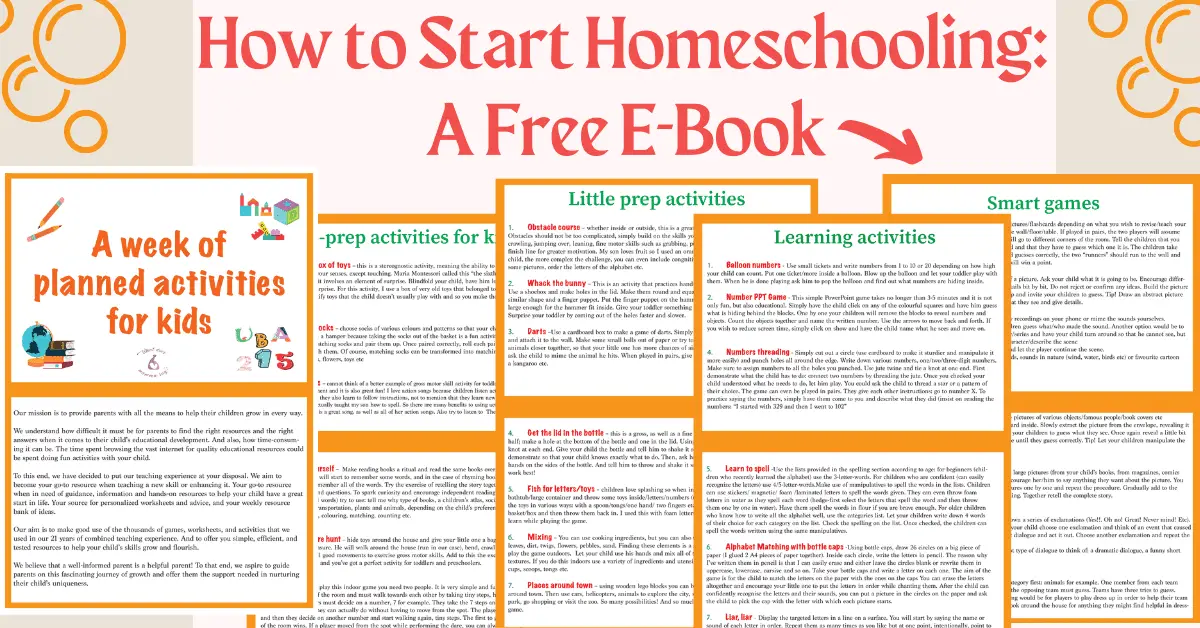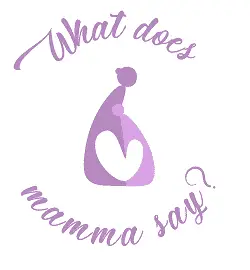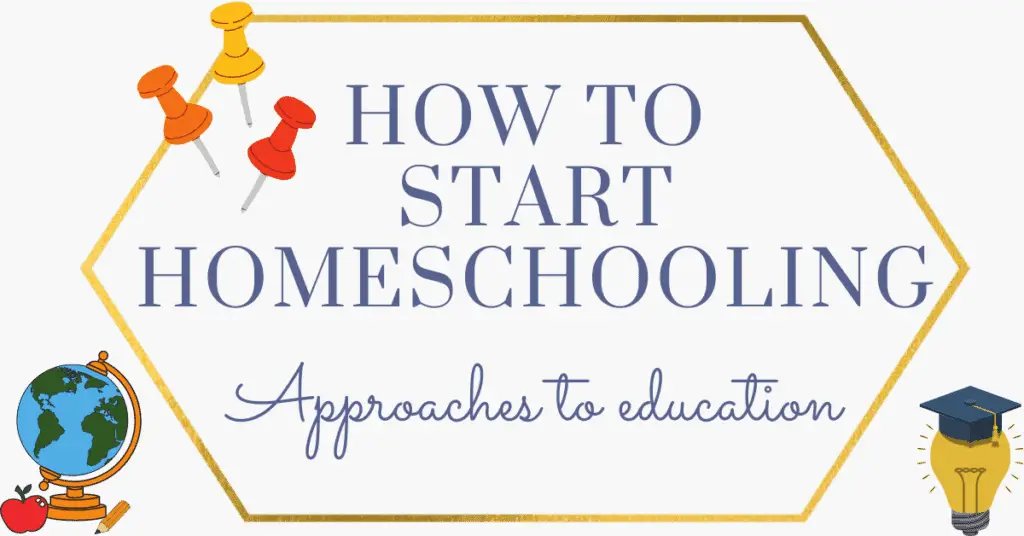There are many reasons why parents decide to start homeschool: children have special needs, others are bullied, parents feel children were not safe enough, children are bored or unhappy, parents believe children’s creativity will be stifled, there is too much formal learning, there are too many children in a classroom, the choice was made based on religious aspects.
Whatever the reason, the decision is not a light one and it has an impact on the whole family.

It is important for parents to know that according to the 1996 Education Act parents are responsible for their children’s education and that this can happen at school or otherwise.
In other words, it is completely legal to home educate. However, parents may be required by local authorities to prove that they provide education appropriate to the child’s age.
This post may contain affiliate links and I may earn a small commission when you click on the links at no additional cost to you. As an Amazon Affiliate, I earn from qualifying purchases. You can read my full disclosure here.
Home-based education: where to start?
Disclaimer: The information and ideas provided in this article are my own personal opinion based on my experience as a teacher and parent. They are by no means the only guidelines to be considered and their effectiveness may vary from person to person.
When they start homeschooling, parents need to know that they do not need to follow the national curriculum. Learn all about the legal aspects of homeschooling in the UK here. In the USA you need to find legal information depending on the state, read all about it on HSLDA.

And also, parents mush know that there is no right way to do it, the most important thing is to choose a direction that best suits the child. Parents can either let the child choose what he wishes to learn or the parents can draw up a timetable and choose which subjects to study. You can even combine these two approaches.
Parents should understand before they start homeschooling that this process requires a lot of flexibility and also a lot of trial and error. For more information about how to approach homeschooling effectively, read A guide for Homeschooling Parents.
Another good start would be to contact other homeschooling families and home education organizations. Moreover, you could try to research what local resources there are: libraries, museums, zoos, community centres etc.
Secondly, we need to realise that learning can happen anywhere and through any kind of activity, be it observing a river, cooking, visiting the doctor, watching an educational programme. However, a child-centred approach should always be considered. Know what type of learner your child is.
You can find out more about multiple intelligences and how you can help your child learn better. Choose activities that are both age-appropriate and suitable for your child’s abilities and interests. Based on my readings, I would suggest a holistic and cross-curricular approach as it is well suited when you start homeschooling.
Flexible schooling
Flexible schooling is also an option, meaning that parents make an arrangement with the school to share responsibility for the child’s education. The child will go to school from time to time and for the rest of the time, parents need to educate the child.
The term itself describes this approach: parents and schools are very flexible, children can go to school for the difficult subjects or only in blocks of time (days, weeks, terms or even one year).
Combine approaches and create a personalized curriculum, and always have your child’s abilities and interests in mind.
The child is still enrolled and under the national curriculum, but parents can play a more active role in their child’s education and avoid over-tiredness, boredom, or irritability.
Flexible schooling is also legal, just like homeschooling, but it is all up to the school’s responsiveness to a parent’s request for flexible-schooling.
Whatever your choice and approach you wish to adopt, bear in mind that there are always advantages and disadvantages when you choose to start homeschooling. However, knowing more about each approach to alternative education can help you make an informed decision.
Read about available options, discover the elements that define it, and decide whether you can adopt them or combine elements from various approaches to home-based education.
Combine approaches and create a personalized curriculum, and always have your child’s abilities and interests in mind.
There is no right or wrong way to go about it and no perfect curriculum. But what we can do as parents is to make an informed decision!
What To Do Before You Start Homeschooling
When I decided to homeschool my son, I read “Alternative Approaches to Education- A Guide for Parents and Teachers” by Fiona Carnie. And soon after I read Yuval Harari’s 21 Lessons for the 21st Century. They both connected and made me think. Both of them clarified what I already believed. These books taught me the most important lessons of home-based education.
On the one hand, we have to become completely aware that we are now preparing children for jobs of the future, of a rapidly progressing future, and continuously evolving.
According to Yuval Harari, people will no longer be the heroes of the future as they were in the past. In a world of machine learning and AI, people might start to feel increasingly irrelevant and this is what people fear most.
On the other hand, preparing children for the future might involve alternative approaches to education, as redesigning the whole educational system could meet various obstacles: political, economic, even ideological.
- simultaneous use of a wide range of skills
- dealing with unforeseen scenarios
- the ability to rethink things and innovate
- life long learning
- self-confidence
- rational thinking
- ability to rapidly adapt to change
should all be on your curriculum if you decide to start homeschooling. Together with social-emotional development, critical thinking skills, and learning how to learn.

Alternative Approaches to Education as Described in Fiona Carnie’s Book
1. Small Schools
Completely built by parents, the idea of a small school first appeared in the 1980s when a group of parents decided not to send their children on a two-hour trip to the nearest school. The small school is learner-centred and alongside academic skills, children learn practical skills as well, such as growing vegetables, sewing, and building.
Small schools adopt a holistic approach to education and foster creative, emotional, moral, and spiritual growth, as well as intellectual development.
There is great emphasis on nurturing a child’s creativity through activities such as storytelling, building a solar shower, African drumming, camping expeditions, or visiting Japan to perform a play. Parents and teachers are the only decision-makers and children take turns cleaning the school or cooking lunch.
Children are also educated to help create a more sustainable future. The number of pupils ranges from 6 to 80 perhaps, depending on the situation. These numbers allow teachers to build strong relationships with their students built on trust and openness.
Read about what makes good learners good.
Small schools adopt a holistic approach to education and foster creative, emotional, moral, and spiritual growth, as well as intellectual development.
There are now various small schools across the UK and each has various priorities. And although there are many disadvantages to small schools, my aim is to present them as inspiration and starting point for parents and teachers who want to start homechooling.
2. Waldorf Education
This movement started in 1919 in Germany when Rudolf Steiner opened the first school. It is a child-centred school and is based on the idea that education is a process of gradual awakening. The purpose of education is to help the child make sense of the world and a holistic approach is needed.
According to R. Steiner. education has to be practical, artistic, and develop the intellect.
Steiner’s curriculum is all about teaching children practical skills from an early age as he believes through making clothes, knitting, cooking, gardening a child learns to think.
Helping children find their voices in schools is essential.
Art is also an important part of the curriculum: children learn music, sculpture, drama, use music to learn tables, learn letters by taking the letter out of a picture(s out of the picture of a snake etc)
Childhood Is Divided Into Three Stages
1. the first stage from birth to 6-7
emphasis on play and learning by doing. There is no formal education at this age: no math or reading, but preparation for these skills takes place through playing: storytelling, cooking, building etc.
It is considered damaging to start formal education so soon. Children play with simple toys to leave room for creativity and play involves imitating adults and learning by example.
2. the second stage from 7 to 14
this stage is called the heart of education; children learn to write first and then to read; they learn through pictures and images rather than imitating. Children learn best from myths and historical stories as children live now more in the realm of their own feelings. From class 1 the child is assigned a teacher who stays with the group for the next 8 years.
The teacher is responsible to create a curriculum appropriate to the group at each stage of their development. The main curriculum areas are covered in the first part of the morning followed by music, arts, craft etc taught by specialist teachers. There is no competition and the children are not given marks for their work, they receive praise and support.
3. the third stage from adolescence to emerging adulthood
there is an emphasis on developing abstract thought and developing questioning minds. The aim of education is to help young people become free, independent, and creative beings.
Children are taught by subject specialists and they are taught in blocks: a teacher chooses a block of lessons on a topic and teaches it every day for 3-4 weeks. Then another specialist teacher takes over and teaches a new topic.
There are 10-11 teaching blocks per year and are all interdependent. Alongside these, there are regular classes of sport, crafts, math, English, foreign language, science, religious education and Eurythmy (a form of movement developed by Steiner)
In a Waldorf school, there is no hierarchy and no headteacher. There is no testing and children’s progress is assessed by their teachers.
Montessori Education
In 1907 Maria Montessori opened her first school after working with special needs children and observing that the methods she was developing were appropriate for all children.
According to M. Montesorri children should be allowed to develop and learn at their own pace without adult interference. Just like Waldorf education, Montesorri education is centred on learning by doing and real-life, practical activities.
Children are encouraged to become independent, there is no praise or criticism, just help and encouragement to try again and again. Children have a large degree of freedom to choose their own activities.
The materials used were designed by Maria Montesorri: beads, puzzles, blocks, and trays of miniature objects. Montessori materials are used to teach about shapes, size, texture, sounds, language, and numbers.
The Montessori Curriculum
The curriculum is designed around three areas: an interest in the world beyond the classroom and abstract concepts, morality, and the development of social awareness. Reading and writing are introduced when the child starts to show interest, usually at around 6.
In the early years, education is all about the practical aspects of day-to-day living.
There is great flexibility in the learning process and children are involved in planning their own work and are also encouraged to evaluate their work. In the early years, education is all about the practical aspects of day-to-day living.
Children venture into society and there is great emphasis on peaceful coexistence and showing respect for others.
There is also a lot of physical exercise: children go for long walks or expeditions, they prepare for them, they learn about orientation, weather predictions and there are many opportunities for contact with the natural world.
Montessori was concerned with developing a sense of responsibility in students and a sense of own-worth that must stem from the feeling that a person has something valuable to offer to society.
Further reading for home-based education
Fiona Carnie’s book also offers a short description of various philosophies in education such as Reggio Emilia, Freinet, Jenaplan, Grundtvig, and John Dewey. Reading about these is also very important as it may help a homeschooling parent choose a specific direction or designing a personalized curriculum, which I strongly encourage.
Moreover, the book offers advice on how to set up your own school, information which I haven’t found that easily online so it’s well worth a read: how to get funding, choosing furniture, teachers and the curriculum, legal aspects and so much more.
We share all of our ideas, on our Facebook group Learning Activities for Kids.
Learning activities for kids

Hi. I am Monica, an experienced ESL teacher and early years student, mother to a preschooler and passionate reader.




Great tips for parents who are looking for ways to homeschool! As a Montessori trained teacher and parent educator, the child led learning model could be a good fit for parents new to homeschooling.
These are all great tips for parents who are looking to homeschool. I am doing virtual learning this year and I know some of these tips will be put to use for sure.
As a homeschool mom for the past 8 years, I think these are great tips! It’s so important to decide on the right homeschooling approach for your kids’ learning styles and for the type of teacher you want to be.
You’ve offered so many great tips and things to think about for homeschooling! This is a great resource for all parents considering this route during this crazy time!
I would’ve found this so helpful when I was preparing to homeschool. This is my 7th year to homeschool and I’ve learned so much over those 7 years.
These are such great and useful tips! So neceaaary especially lately!
Great tips and things to think about! Thanks for sharing.
As a mom who is currently looking into homeschooling, this was really great content.
So many great resources!! WOW!
Great tips! My babies have never been to a conventional school as we’ve decided to take up homeschooling. This is a fantastic resource, thank you!
Highly informative article, thank you.
Thank you for discussing the development stages of the child. This is an important factor to consider in planning the child’s education and what curriculum or study plan might be best for them.